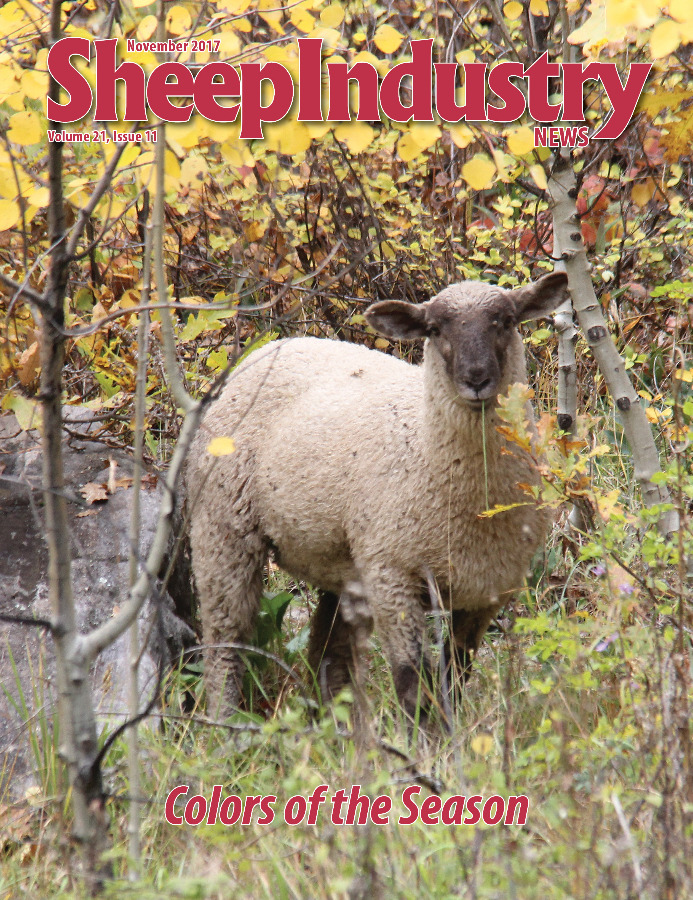
- November 2017
- President’s Notes
- NSIP, Breeds Find Common Goals
- NSIP Adds Searchable Database
- Sheep Prove More Reliable than Weather in Bayfield
- Cestari Hoping to Rebuild Wool Sheep Numbers Back East
- Tips for Culling & Selecting Ewes
- Young Entrepreneur: Katie Forrest
- Obituaries
- Around the States
- Market Report
- The Last Word
NSIP Adds Searchable Database
TERRI QUECK-MATZIE
Special to the Sheep Industry News
Advancement of the American sheep industry depends on genetic improvement of its breeding and commercial stock.
Working from the need to introduce quantitative genetics identified by the American Lamb Board’s Sheep Industry Road Map, the National Sheep Improvement Program has created its system of Estimated Breeding Values, and developed tools such as the NSIP Ram Buying Guide.
Now, another NSIP project funded by ASI Let’s Grow grant funds takes ram selection a step further, putting pedigree and performance data at your fingertips with an online searchable database.
“This project focuses on disseminating the genetics for enhanced production and profitability into commercial flocks by making it easier to select rams based on EBVs tailored to the individual flock,” says NSIP Program Director Rusty Burgett. “The database will allow producers to search by breed through all rams available that have the desired EBVs for productivity improvement.”
The database is accessible though the NSIP website and easy to use. Simply plug in the breed group, breed, gender and preferred birthdate of breeding stock. Then supply the desired range of specific EBVs to meet your flock’s needs.
“The app will guide producers selecting rams based on EBVs for economically important traits,” says Burgett, who showcased the app at this season’s ram sales and will continue to educate producers on its use through upcoming workshops around the country.
“What this does, is increases access to NSIP for people not previously buying breeding stock according to EBVs,” says Let’s Grow Program Coordinator Alan Culham. “For producers who are used to using NSIP’s quarterly percentile rankings, this goes a step further to show how available sheep differ in any one, or all, traits.”
Culham adds there are limitations, like the inability to compare performance across breeds. “But it’s still infinitely better than what was available a few years ago.”
The searchable database also gives a boost to breeders wanting to expand their market.
“There are breeders out there who are better at breeding than marketing,” says Culham. “This provides greater access to their stock by potential buyers.”
Shopping by the numbers is common in other species of livestock. Beef, with it’s Expected Progeny Differences, set the stage decades ago, yet still lacks a comprehensive searchable database. Specific breeds have developed similar models, and provided viable examples for NSIP’s effort.
“The sheep industry definitely has the advantage of not having to re-invent the wheel,” says Culham. “Much of the research has been done, and the mistakes were made by other industries.”
“This tool will allow the commercial sheep producer the ability to see the same kind of returns as the NSIP members,” says Burgett. “By finding the right rams, you can add pounds to the truck at shipping and greater returns on the check. NSIP members have reaped these benefits over the years but now this will help the commercial sector capitalize.”
Sheep breeds that have utilized NSIP EBVs have made progress. In the past 10 years, the Polypay breed has increased total weight of lambs weaned per ewe by 10 pounds. The Suffolk breed has increased market weight by 5 pounds, while increasing loin eye area and decreasing fat. The Targhee breed has increased total weight of lamb and wool produced per ewe by 10 pounds, while maintaining wool quality. And the Katahdin breed has increased total weight of lambs weaned per ewe by more than 6 pounds, while increasing internal parasite resistance.
“These measured improvements could also be seen in commercial lamb production with wider adoption of the technology,” says Burgett. “Both maternal and terminal traits can be improved, leading to more pounds of lamb produced with a constant ewe flock size.”
“We simply have to do more with less,” adds Culham. The multiple birth factor, with a heritability of 10 to 15 percent, is a good example. “We’re not able to drive twinning without the use of EBVs. You can’t look at a ram and know his daughters will produce 20 percent more lambs. It takes data to identify the genetics that can do that. If you’re going to buy a ram, why not look at the value his daughters are going to have in your flock?”
Choosing the right ram is using money wisely. That goes beyond lambing rates. The right genetics can improve lamb consistency and quality, ultimately creating demand as consumers grow more familiar with the product.
“Utilizing terminal sires selected for carcass merit increases the ability to sire lambs with the genetic potential to produce lean meat with reduced fat deposition, at an accelerated rate of gain, to harvest lambs at an earlier age,” says Burgett.
It’s one of the ways NSIP seeks improved alignment of all sectors of the industry.
“Our primary objective is to increase the use of EBVs in ram selection by making selection decisions easier for producers,” says Burgett. “That’s how we will meet our common goals, and increase the productivity of sheep flocks industry-wide over time.”
It’s one more way to make sheep more productive, efficient and profitable.
More information on NSIP, including a link to the searchable database can be found at NSIP.org.

